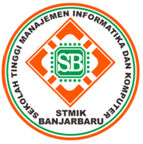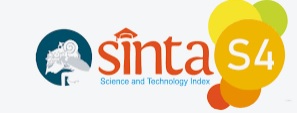Implementasi Arsitektur Half-UNet untuk Mendeteksi Kanker Payudara pada Citra Ultrasonografi
Abstract
Breast cancer is one of the biggest causes of death for women worldwide. Breast cancer is a metastatic cancer and can spread to other organs, such as bones, liver, lungs and brain. Breast cancer can be detected at an early stage, but it is difficult to find and cases of breast cancer are on the rise. Therefore, this study uses the Half-UNet architecture for breast cancer sonogram dataset. The dataset used consists of 780 breast sonograms which are divided into training data and test data with a ratio of 80:20. The Dice Coefficient results obtained on the Half-UNet architecture is 0.7063. The U-Net value can provide better Dice Coefficient results, but the Half-UNet architecture has comparable values and provides results in a relatively faster time.
References
F. Bray, J. Ferlay, I. Soerjomataram, R. L. Siegel, L. A. Torre, and A. Jemal, “Global cancer statistics 2018: GLOBOCAN estimates of incidence and mortality worldwide for 36 cancers in 185 countries,†CA. Cancer J. Clin., vol. 68, no. 6, pp. 394–424, Nov. 2018. doi: 10.3322/caac.21492.
Y. S. Sun et al., “Risk factors and preventions of breast cancer,†International Journal of Biological Sciences, vol. 13, no. 11, pp. 1387-1397, Nov. 2017. doi: 10.7150/ijbs.21635.
G. N. Sharma, R. Dave, J. Sanadya, P. Sharma, and K. K. Sharma, “Various types and management of breast cancer: An overview,†Journal of Advanced Pharmaceutical Technology and Research, vol. 1, no. 2, pp. 109-126, Apr. 2010.
L. Abdelrahman, M. Al Ghamdi, F. Collado-Mesa, and M. Abdel-Mottaleb, “Convolutional neural networks for breast cancer detection in mammography: A survey,†Computers in Biology and Medicine, vol. 131, pp. 104248, Apr. 2021. doi: 10.1016/j.compbiomed.2021.104248.
O. Ronneberger, P. Fischer, and T. Brox, “U-net: Convolutional networks for biomedical image segmentation,†in Lecture Notes in Computer Science (including subseries Lecture Notes in Artificial Intelligence and Lecture Notes in Bioinformatics), Munich, Germany, 234-241, 2015. doi: 10.1007/978-3-319-24574-4_28.
J. Aprilyanto and Y. Yohannes, “Implementasi Arsitektur VGG-Unet Dalam Melakukan Segmentasi Keretakan pada Citra Bangunan,†MDP Student Conf., vol. 2, no. 1, pp. 257-264, Apr. 2023. doi: 10.35957/mdp-sc.v2i1.4311.
H. Lu, Y. She, J. Tie, and S. Xu, “Half-UNet: A Simplified U-Net Architecture for Medical Image Segmentation,†Front. Neuroinform., vol. 16, pp. 911679, June 2022. doi: 10.3389/fninf.2022.911679.
A. K. Singh and B. Gupta, “A Novel Approach for Breast Cancer Detection and Segmentation in a Mammogram,†Procedia Computer Science, vol. 54, pp. 676-682, 2015. doi: 10.1016/j.procs.2015.06.079.
V. K. Saubhagya, A. Rani, and V. Singh, “ANN based detection of Breast Cancer in mammograph images,†in 2016 IEEE 1st International Conference on Power Electronics, Intelligent Control and Energy Systems (ICPEICES), Delhi, India, 1-6, 2016. doi: 10.1109/ICPEICES.2016.7853734.
W. M. Salama and M. H. Aly, “Deep learning in mammography images segmentation and classification: Automated CNN approach,†Alexandria Eng. J., vol. 60, no. 5, pp. 4701-4709, Oct. 2021, doi: 10.1016/j.aej.2021.03.048.
T. Sadad et al., “Identification of breast malignancy by marker-controlled watershed transformation and hybrid feature set for healthcare,†Appl. Sci., vol. 10, no. 6, pp. 1900, 2020, doi: 10.3390/app10061900.
K. Jabeen et al., “Breast Cancer Classification from Ultrasound Images Using Probabilityâ€Based Optimal Deep Learning Feature Fusion,†Sensors, vol. 22, no. 3, pp. 807, 2022, doi: 10.3390/s22030807.
R. Almajalid, J. Shan, Y. Du, and M. Zhang, “Development of a Deep-Learning-Based Method for Breast Ultrasound Image Segmentation,†in 2018 17th IEEE International Conference on Machine Learning and Applications (ICMLA), Orlando, USA, 1103-1108, 2018. doi: 10.1109/ICMLA.2018.00179.
W. Al-Dhabyani, M. Gomaa, H. Khaled, and A. Fahmy, “Dataset of breast ultrasound images,†Data Br., vol. 28, pp. 104863, Feb. 2020, doi: 10.1016/j.dib.2019.104863.
K. Han, Y. Wang, Q. Tian, J. Guo, C. Xu, and C. Xu, “GhostNet: More features from cheap operations,†in 2020 IEEE/CVF Conference on Computer Vision and Pattern Recognition (CVPR), Seattle, USA, 1577-1586, 2020. doi: 10.1109/CVPR42600.2020.00165.
X. Li, X. Sun, Y. Meng, J. Liang, F. Wu, and J. Li, “Dice loss for data-imbalanced NLP tasks,†in Proceedings of the 58th Annual Meeting of the Association for Computational Linguistics, 465-476, July 2020. doi: 10.18653/v1/2020.acl-main.45.
M. S. K. Inan, F. I. Alam, and R. Hasan, “Deep integrated pipeline of segmentation guided classification of breast cancer from ultrasound images,†Biomed. Signal Process. Control, vol. 75, pp. 103553, May 2022, doi: 10.1016/j.bspc.2022.103553.
C. Qin et al., “Dynamically aggregating MLPs and CNNs for skin lesion segmentation with geometry regularization,†Comput. Methods Programs Biomed., vol. 238, pp. 107601, Aug. 2023, doi: 10.1016/j.cmpb.2023.107601.
M. F. Dar and A. Ganivada, “EfficientU-Net: A Novel Deep Learning Method for Breast Tumor Segmentation and Classification in Ultrasound Images,†Neural Process. Lett., 2023, doi: 10.1007/s11063-023-11333-x.
S. W. Cho, N. R. Baek, and K. R. Park, “Deep Learning-based Multi-stage segmentation method using ultrasound images for breast cancer diagnosis,†J. King Saud Univ. - Comput. Inf. Sci., vol. 34, no. 10, pp. 10273-10292, Nov. 2022, doi: 10.1016/j.jksuci.2022.10.020.
How To Cite This :
Refbacks
- There are currently no refbacks.










